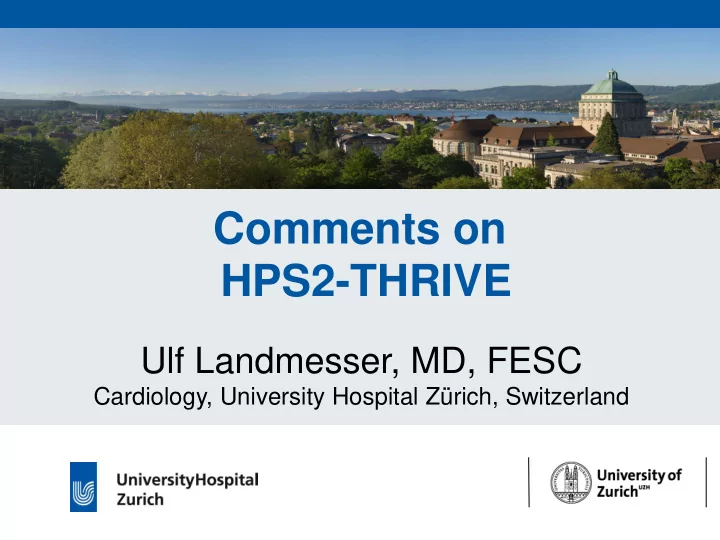

Comments on HPS2-THRIVE Ulf Landmesser, MD, FESC Cardiology, University Hospital Zürich, Switzerland
Seite 1 U.Landmesser - Disclosures Speaking or consulting: Roche, MSD, Pfizer Research grants: Roche, Merck
Seite 2 Comments on HPS2-THRIVE Treatment of HDL to Reduce the Incidence of Vascular Events 1. Lipid-targeted therapies – what should be added to statins ? 2. Niacin – the first lipid-modifying drug - what have we learnt ? 3. Comments on HPS2-THRIVE analysis 4. Comparison between AIM-HIGH and HPS2-THRIVE
Seite 3 Lipid-targeted Therapies - What should be added to statins in patients with high vascular risk ? Statin therapy Further HDL-C LDL-C Combined LDL-C • Reconstituted HDLs • NPC1L1 (Ezetimibe * ) HDL-C • ApoA1 modulation • PCSK9 inhibition • Niacin/Laropiprant * (Monoclonal Ab * ) • • ApoB-100 Antisense CETP inhibition oligonucleotides (Anacetrapib *, Evacetrapib * ) * Clinical outcome trials ongoing
Seite 4 Role of HDL function versus HDL cholesterol levels ? Different effects of HDL from patients with CAD on inflammatory activation n.s. Number of GCSF-labeled monocytes 35 P < 0.05 P < 0.05 30 per high power field 25 20 15 10 5 0 TNF α + TNF α + TNF α + TNF α Baseline Healthy Stable CAD ACS HDL HDL HDL Effect of HDL on monocyte adhesion to TNF α -stimulated endothelial cells Besler C et al.. J Clin Invest 2011;121: 2693-708
Seite 5 Comments on HPS2-THRIVE Treatment of HDL to Reduce the Incidence of Vascular Events 1. Lipid-targeted therapies – what should be added to statins ? 2. Niacin – the first lipid-modifying drug - what have we learnt ? 3. Comments on HPS2-THRIVE analysis 4. Comparison between AIM-HIGH and HPS2-THRIVE
Seite 6 Niacin – the first lipid-modifying drug 1955 Niacin (vitamin B3) - first antidyslipidemic agent (>50 years of clinical use) 1975 Coronary Drug Project (1,119 patients on niacin) 2003 Discovery of niacin receptor (GPR109A) 2009 Coadministration of DP 1 antagonist laropiprant reduces flushing (1,455 patients)
Seite 7 Proposed model of niacin-associated adverse skin effects Dunbar RL, Gelfand JM. J Clin Invest 2010;120: 2651-5
Seite 8 Comments on HPS2-THRIVE Withdrawal of active ER-Niacin/laropiprant before randomization: For any medical reason: 25.4 % Approximately - Skin (11.3. %) (Pruritus, rash, flashing) 2/3 of patients - GI symptoms (5.5%) can tolerate ER-Niacin/ Withdrawal in randomized treatment phase: laropiprant - Skin symptoms (5.1 vs. 1.2 %) (mostly pruritus) therapy - GI symptoms (3.6 vs. 1.6 %) (upper and lower GI)
Seite 9 Comments on HPS2-THRIVE: Safety analyses Myopathy increased: 62/69 (0.5%) vs. 10/12 (0.1%) Largely in patients with Chinese descent Rhabdomyolysis: 7 (0.05%) vs. 3 (0.02%) Caution Severe liver disease in patients (3x ULN + bilirubin ≥2x ULN): 15 (0.1 %) vs. 18 (0.1 %) with chinese descent FDA approved label change for simvastatin: (myopathy) ” Patients of Chinese descent should not receive simvastatin 80 mg with cholesterol-modifying doses of niacin-containing products. Caution is recommended when such patients are treated with simvastatin 40 mg or less in combination with cholesterol- modifying doses of niacin-containing products. ”
Seite 10 Niacin – the first lipid-modifying drug 1955 Niacin (vitamin B3) - first antidyslipidemic agent (>50 years of clinical use) 1975 Coronary Drug Project (1,119 patients on niacin) 2003 Discovery of niacin receptor (GPR109A) 2009 Coadministration of DP 1 antagonist laropiprant reduces flushing (1,455 patients) 2011 AIM-HIGH Study 2013 Clinical outcome data of HPS2-THRIVE
Seite 11 Comparison HPS2-THRIVE and Aim-High trial AIM-HIGH trial HPS2-THRIVE trial ( N Engl J Med 2011) • Pre-randomisation phase with niacin • Pre-randomisation phase with ER-niacin (2g)/ (1.5/2g) exclusion: 20.1 % laropiprant exclusion: 25.4 % • Aiming to have similarly low LDL-C in both • No further adjustment of LDL-C levels after treatment groups randomization LDL: - 5.5 %, HDL: + 13.2 % LDL: -20 %; HDL + 17 % More patients on high-dose statin Addition of laropiprant or ezetimibe in control-group (Antagonist of PGD 2 receptor DP 1 ) • Randomization (n): 1718 vs. 1696 patients • Randomization (n): 12838 vs. 12835 patients • Mean FU - 3 years (556 events) • Mean FU - 4 years (? events) HPS2-THRIVE clinical outcome data (presentation expected in 2013)
Thank you
Recommend
More recommend